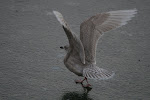My Main objective was to observe the ever present Gulls that feed on Arpley tip (adjacent to the site) and then bathe on Birchwood pool before heading off to the Mersey to roost.
 1stw Glaucous Gull
1stw Glaucous Gull

 My best find was a 1stw Glaucous Gull that came in with a large group of imm Herring Gulls early Afternoon. I was the first one to stop this at the time which was an acheivment for me. The bird itself was a very striking bird with pale wing and mantle feathers with almost peach head neck and belly. It only stayed breifly but it flew past the hide at about 10 meters as I got a couple of rushed flight shots.
My best find was a 1stw Glaucous Gull that came in with a large group of imm Herring Gulls early Afternoon. I was the first one to stop this at the time which was an acheivment for me. The bird itself was a very striking bird with pale wing and mantle feathers with almost peach head neck and belly. It only stayed breifly but it flew past the hide at about 10 meters as I got a couple of rushed flight shots. ad w/s Mediterannean Gull
ad w/s Mediterannean Gull

 There was a nice 2ndw/s Med Gull that was showing a lot of black head feathers which stayed for about 2 hours until it moved off to the mersey with Black Heads when everything got flushed by an over flying Merlin
There was a nice 2ndw/s Med Gull that was showing a lot of black head feathers which stayed for about 2 hours until it moved off to the mersey with Black Heads when everything got flushed by an over flying Merlin Little Grebe - there were several pairs of these in varying plumages. I would estimate 10 pairs on Birchwood Pool alone!
Little Grebe - there were several pairs of these in varying plumages. I would estimate 10 pairs on Birchwood Pool alone! One of the many immature Great Black Backed gulls.
One of the many immature Great Black Backed gulls. Adult Common Gull.
Adult Common Gull.There was a lot of the reserve that I did not look at due to myself being stuck to my scope the whole time i was there! My parents and uncle went away at about 1pm to get some food whilst I stayed with a couple of Gullers.
On the Tip itself, in the moring there was an impressive total seen with 3rdw Kumlein's Gull, 2 Iceland Gulls, 2x1stw Glaucous Gulls, 2 Med Gulls, 1 clinched Caspian and 3+ Yellow Legged Gulls
I managed to see from the hide(overlooking the pool and the skyline above the tip) 2x1stw Glaucous Gulls, 2 (adult, 1stw) Yellow Legged Gulls, 1 2ndw Med Gull and the Gull below which proved to be a tricky individual. [see below for details]
What was beleived to be a sub-Adult Caspian Gull proved quite the talking point as it bathed amongst Adult and immature Herring and Great Black Backed gulls. It showed a long parrallel Bill with a small dark eye(2) and compared to the Herrings around, it was clearly a shade darker in the mantle feathering(1). All of these signs pointed to Caspian and it certainly was, in the field, a very characteristic bird. However, with several photographers in the hide, the photographs of the bird batheing revealed that primary 10 was the same as a herring gull at the same age, which is apparent, but then again you can't really call it either way. Hopefully at a later date, with the bird being compared to other birds, we will be able to call it a 4th Calender Year Caspian Gull, but until then, this is just an unusual Herring type Gull.




No comments:
Post a Comment